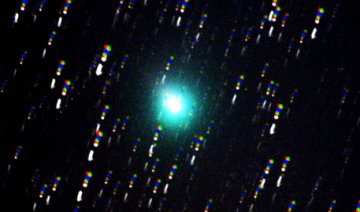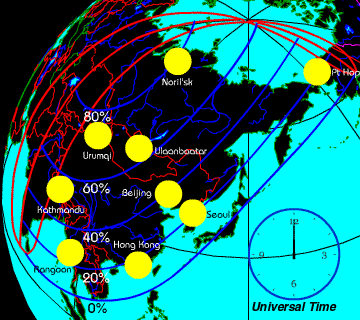 The space shuttle flies in April. Would you like a call when it soars over your backyard? Spaceweather PHONE!
The space shuttle flies in April. Would you like a call when it soars over your backyard? Spaceweather PHONE!
PLUTO OCCULTATION: Tomorrow morning, Sunday, March 18th, Pluto will pass directly in front of a 15th-magnitude, red star in the constellation Sagittarius. This occultation will be visible through large backyard telescopes in the western United States, offering a rare look into Pluto's surprising atmosphere. Experienced amateur astronomers are encouraged to observe.
NEW COMET LOVEJOY: On March 15th, Terry Lovejoy of Thornlands, Australia, discovered a new comet (C/2007 E2) in the southern constellation Indus. Remarkably, to make the find he used not a telescope but just a camera--a Canon 350D. At Lovejoy's request, John Drummund of Gisborne, New Zealand, confirmed the comet with this photo taken through a 0.41-m reflector:

Photo details: 16" Newtonian @f5.2, SBIG STL11000M CCD, 3 minutes
The new comet is green, 9th-magnitude, and located approximately at right ascension 20h 42m 55s, declination -50o 43' 14" (ref: International Astronomical Union Circular 8819). A detailed ephemeris is not yet available, so it is impossible to say how bright Comet Lovejoy will become--or even which way it will go. Stay tuned for updates.
SOLAR ECLIPSE: On March 19th around 0230 UT, the Moon will pass in front of the Sun, producing a partial solar eclipse visible from Russia, India, China and the northern reaches of Alaska. In those places the normally-round Sun will turn into a crescent and cast strangely-curved shadows on the ground.

Eclipse visibility map. Credit: Larry Koehn of ShadowandSubstance.com
Caution: Even a sliver of exposed sun can be blindingly bright. Sky watchers in the eclipse zone should excercise care and use safely-filtered solar telescopes or #14 welding glasses to observe the partial eclipse.
Partial Eclipse Photo Gallery
[animations] [astronomy alerts]

